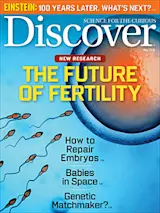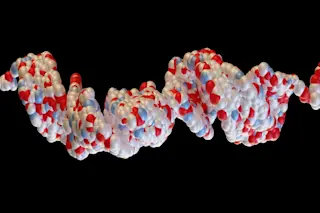A singular obsession defines George Church’s life. He wants to crack open the cellular machinery of every human on Earth and read their genetic blueprint.
Tall and thin with an enormous white puffy beard and hair to match, Church looks like he’d be as comfortable at Hogwarts as he’s been at Harvard Medical School, where he is a professor of genetics, over the past three decades. His projects can seem just as wizardly. Church has explored everything from reversing aging to resurrecting the woolly mammoth, and he helped launch the revolutionary Human Genome Project (HGP), which sequenced human DNA in its entirety.
But it’s another goal — one Church has never stopped working on — that could carry the greatest potential to alter life on our planet. Ever since his work on HGP, he’s been trying to sequence the rest of us. And he wants to use that information to shape how we pick our mates.
From Parent to Child
The blueprint of any life-form can be found in that organism’s DNA. These strands are condensed into packages called chromosomes; humans have 23 pairs. At the moment of conception, an embryo gets one copy of each — including tens of thousands of genes — from each parent.
In general, genes for a particular trait are either dominant or recessive. Dominant genes overpower recessive ones. So, a child dealt both a dominant and a recessive gene ends up with the trait encoded by the dominant gene.
Most of us carry recessive genes for various diseases inside our DNA. We can go through life unharmed because we also have a healthy, dominant copy of the gene. But when two parents who each carry a defective copy of a gene have a child, there’s a risk that their offspring could end up with two defective copies of the gene. Worldwide, roughly 5 percent of children are born with serious birth defects caused by a single gene
However, if each of us had our genome sequenced — and used it to choose lovers — we could change that. Church estimates such an effort would effectively end some 7,000 genetic diseases, from sickle cell anemia to cystic fibrosis. Stretched to its fullest potential, he says, it could save 50 million lives a year. That’s Church’s goal.
Update: In December 2019, Church announced a dating app called Digid8 meant to do just that. Speaking to the MIT Technology Review, he claims it would run in the background of other dating apps, preventing those with identical recessive genes from meeting and having children.
He likens genome sequencing to the internet back in the early 1990s. Sure, it existed, but people didn’t know what to do with it. Its world-changing potential sat for years, waiting to be unlocked.
Several things have held back Church’s dream. Until recently, the price of full genome sequencing was too high, and not enough people were willing to get sequenced — either because they didn’t see the value or had privacy concerns. Church and others have largely solved the first problem. Now, he’s convinced he’s found a solution to the other.
The Alta Summit
For five days in December 1984, blizzards hammered Alta Ski Area in the Wasatch Mountains outside Salt Lake City. Between powder runs, the world’s top geneticists hunkered down in the lodge and brainstormed. The U.S. government had invited them there to help detect genetic mutations among atomic blast survivors and their children. Their consensus: The technology wasn’t there yet, but it could be. As the snowed-in scientists advanced their talks, they inadvertently launched one of the largest, most expensive research endeavors in history: the HGP.
Church was at the center of those talks. His 1984 Harvard University Ph.D. thesis on genome sequencing techniques had already laid some of the groundwork for what would become the $3 billion project. But, when the first human genome sequence was finally published in 2003, to Church, it was only the beginning.
In the years since, he’s advised or co-founded dozens of scientific projects and biotech companies. Their common thread: bringing genome sequencing to the mainstream.
With the launch of the Personal Genome Project in 2005, Church’s research team set out to create a vast database of genomes from volunteers — so far, they’ve netted 10,000 genomes. He’s also been working with the genetic testing company 23andMe since before its launch in 2006. Plus, he started Veritas Genetics, which has now driven the cost of whole genome sequencing plus analysis below $1,000. “We’ve brought the cost down about 10 millionfold,” Church says. And in the coming years, he expects technology advances should lower the cost by another order of magnitude.
But along the way, he saw that lowering the cost isn’t enough to accomplish his goal of sequencing humanity’s genome. “I realized that even if it was zero dollars, a lot of people would not get their genome sequenced,” Church says.
Part of that is because people are worried about their genetic privacy, he says. In 2018, a survey from the Harris Poll found that about half of all Americans are either “extremely” or “very concerned” about the security of their health care data. Most of that concern is related to medical data breaches and identity theft. And services like 23andMe (where Church still serves as an adviser) have drawn controversy by selling their customers’ genetic data.
Another part boils down to simple apathy. “Most people don’t care,” Church says. “You need to motivate them.”
He hopes his latest effort, a company called Nebula Genomics, will address all of those issues.
Nebula’s goal is to pay for people to get their genome sequenced, and use encryption techniques to keep health record transactions totally anonymous. As an extra incentive, users could choose to turn around and rent out their data, with identifying information removed, to researchers and drug companies.
But genome sequencing takes money. To that end, Church has been, mostly metaphorically, hitting the road with a pitch for every health insurance executive in America.
It goes like this: Five percent of children globally are born with serious birth defects caused by a single gene. These illnesses can be tragic for families and cost insurers millions per child. However, providers could avoid those costs if they were willing to pay for their patients to have their whole genomes sequenced. Participants would then receive free genetics counseling from their health care provider.
The resulting savings could be reinvested: Just $1 million could sequence thousands of future parents, saving even more money and lives.
As of right now, no insurance companies have bought in. But Church is optimistic about Nebula’s potential to save them money. “It will go exponential very quickly,” he says.
Church also has an answer for those worried about a dystopian future. In some communities, he points out, people are already using genetic data to decide whom to love and marry.
Matchmaker, Matchmaker
Genetic matchmaking is simply a part of marriage for one Jewish community. Decades ago, about 1 in 3,600 children born to orthodox Ashkenazi Jewish parents were diagnosed with Tay-Sachs disease, a rare, recessive genetic disorder that appears a few months after babies are born. The disease progressively kills nerve cells until the infant can no longer crawl or even turn over. Eventually, the child dies.
The situation prompted scientists and community members to come up with a plan. In high school, boys and girls have their DNA sequenced. They’re assigned a number, but not told if they’re a carrier of the disorder. Once a couple is ready to get married, they send their numbers to religious officials, who compare them. If neither person — or just one — is a genetic carrier, they’re simply told that they’re likely a healthy match. But if both carry genes for Tay-Sachs, the couple is informed and given genetic counseling about their options. Thousands of Ashkenazi couples go through the process every year, and more than 4,500 have decided not to get married as a result. It’s already helped reduce cases of Tay-Sachs significantly.
Church imagines a variation of this program for couples everywhere. Existing social media and online dating sites could be modified to implement this kind of genetic matchmaking at a population scale — for all diseases.
In Church’s vision, these kinds of services would add in a genetic screener. If a match might lead to offspring with a fatal disease, you wouldn’t be shown that person. To ensure the privacy of those screened out, a few people would be randomly removed as well.
The prospect of giving up on love simply because an algorithm has decided you may be unfit — like the Ashkenazi model — might be a little much for some people. But that’s not necessarily where such a system might lead.
“I don’t think people are going to do that,” says Stanford University bioethicist Hank Greely, who specializes in the legal and ethical issues of genetics. He says it’s silly to think you could generalize from one tight-knit group to the rest of the U.S. “It’s a very different culture from the rest of the country,” he says.
Instead, he suspects that if people did get their genome sequenced, they might use the information to gauge their risk of having children with genetic diseases. Then they might decide to roll the dice, adopt, not have kids or use pre-screened, implanted embryos.
Greely also downplays another common fear. It would be almost impossible for people to use their genome sequences alone to produce designer babies, he says. That’s because most traits, like height or intelligence or even eye color, involve a huge number of genes, many of which are unknown. By contrast, many genetic diseases come from just a single gene.
And as far as discrimination from employers and insurance companies goes, Church is counting on the Genetic Information Nondiscrimination Act of2008. The law made genetic discrimination illegal in the U.S., though it doesn’t cover some services, like life insurance.
Church says no insurance companies would have access to discriminatory information about patients’ genetic data. But insurance companies, and even patients, wouldn’t necessarily have to see the genomes to benefit, he adds. Software could play matchmaker for family planning, tipping couples off to problems and cutting rates of genetic diseases.
Furthermore, Greely says he’s not really worried about people getting access to his genomic data, even though he doubts Nebula — or any other company — can guarantee their databases won’t be hacked. “I’m far more concerned with my credit card receipts and Google search history,” he says. “Those say a lot more about me and my life than my genes do.”
In the end, Greely says the biggest concern may be having everyone walking around thinking about their genetic fates. Armed with knowledge of your predisposition to a certain disease, you might be able to take preventive action. But for many conditions, there’s no cure. “Do you really want to know all that info?” he asks.
Eric Betz is digital editor of Discover. He's on Twitter: @ericbetz. This story originally appeared in print as "Love, Genetically."

This story is part of "The Future of Fertility" a new series on Discover exploring the frontiers of reproduction.
Read more:














